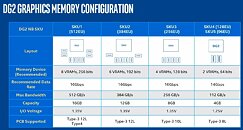
Intel Arc A350M Mobile Graphics Card Pictured & Tested
The recently announced Intel Arc A350M mobile graphics card is now shipping with it's recent debut in the South-Korean exclusive Samsung Galaxy Book2 Pro laptop. The A350M is the entry-level Arc Alchemist skew from Intel featuring an ACM-G11 GPU with 768 shaders and 4 GB of GDDR6 video memory. This specific Samsung Galaxy Book2 Pro model is also equipped with an Intel Core i5-1240P Alder Lake processor and 16 GB of LPDDR5 memory. The Intel video drivers (30.0.101.132) included with the laptop appear to have issues correctly identifying the card however newer versions are available which should address this.
The laptop was tested in various synthetic and gaming scenarios with the Arc A350M (30 W) performing anywhere from 40% to 60% faster than the NVIDIA MX450 (25 W). The Intel A350M reached a maximum boost clock of 2.2 GHz during gaming with the card offering adequate performance in eSports and older titles. The Galaxy Book2 Pro model with 32 GB of memory and a 1 TB SSD (NT950XEE-XD72S) is currently available to purchase directly from Samsung Korea for 2,520,000 KRW (2,054 USD). Intel has noted that more laptops featuring Arc Alchemist mobile graphics should be launching worldwide in the coming weeks.
The laptop was tested in various synthetic and gaming scenarios with the Arc A350M (30 W) performing anywhere from 40% to 60% faster than the NVIDIA MX450 (25 W). The Intel A350M reached a maximum boost clock of 2.2 GHz during gaming with the card offering adequate performance in eSports and older titles. The Galaxy Book2 Pro model with 32 GB of memory and a 1 TB SSD (NT950XEE-XD72S) is currently available to purchase directly from Samsung Korea for 2,520,000 KRW (2,054 USD). Intel has noted that more laptops featuring Arc Alchemist mobile graphics should be launching worldwide in the coming weeks.



















































